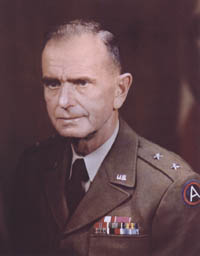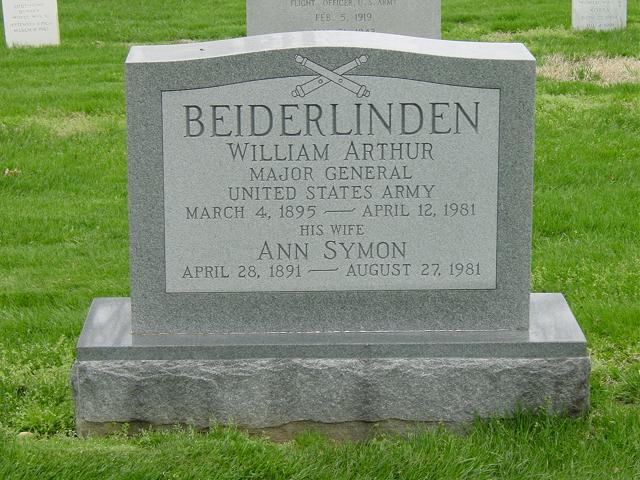William Arthur Beiderlinden was born on March 4, 1895. He attended Drury College in his hometown of Springfield, Missouri, from 1913 to 1917 as a pre-medical student. As a student, Beiderlinden was a member of Lambda Epsilon, a scientific honorary society, and served as the president of that organization during his senior year. As a junior, he was a member of the yearbook board. He was also a member of Obelisk, a local fraternity that joined the Sigma Nu national fraternity in 1919.
He graduated in 1917 with a Bachelor of Science degree. His wife, Ann Symon Beiderlinden, also attended Drury and graduated in 1920. They married on Thanksgiving Day, 1917.
After graduation, he enlisted and served with the Missouri National Guard until November 26, 1917, when he was commissioned a first lieutenant of the Field Artillery.
On Christmas Eve 1917 he sailed to France for duty with the American Expeditionary Forces. During World War I he studied at the Field Artillery School at Samur, served as an instructor at the Coast Artillery School, and fought on several sectors of the front with the 30th Separate Artillery Brigade. He returned to the United States in March 1919 and was commissioned in the Regular Army.
Following assignments with the 83rd Field Artillery at Camp Knox, Kentucky, and Fort Benning, Georgia, Lieutenant Beiderlinden attended the Field Artillery School and graduated in June 1926. He then was assigned to Camp Lewis, Washington with the 10th Field Artillery. In January 1928 he became the Adjutant, and later Commander, of the Headquarters and Headquarters Battery, 3rd Field Artillery Brigade.
Following his promotion to Captain in February 1930, he served as Associate Professor of Military Science and Tactics at the University of Missouri, from June of that year until
October 1934, when he was reassigned to Fort Stotsenburg, Philippine Islands.
While stationed in the Philippines with the 24th Field Artillery (Philippine Scouts), he served as the Regimental Supply Officer (S-4), was promoted to Major (December 1938), and then served as the Plans and Training Officer (S-3).
In June 1939, Major Beiderlinden graduated from the Command and General Staff College and was assigned to Fort Benning, Georgia, as Executive Officer, 1st Battalion, 83rd Field Artillery. During this period, the 83rd Field Artillery participated with the 1st Division during intensive training at Fort Benning and the Louisiana Maneuver area.
He was named Assistant Chief of Staff, G-3, 4th Motorized Division, in June 1940. In April 1941 he was promoted to Lieutenant Colonel and became the division’s Assistant Chief, G-4. During this period, he helped develop operational and administrative procedures which became standard for various echelons. In December 1941, the division moved from Fort Benning to Camp Gordon, Georgia. Six months later, in June 1942, he was promoted to Colonel and became the Assistant Chief of Staff, G-4, of the X Corps at Sherman, Texas.
In March 1943 he was promoted once again, and reassigned to Fort Lewis, Washington, where he became the Commanding General, 44th Division Artillery. The high standards that Brigadier General Beiderlinden instilled not only superbly fitted his Division Artillery for combat, but materially raised the disciplinary and training standards of the entire 44th Infantry Division.
In January 1944, the division left for Louisiana Maneuvers to practice tactics, coordination and teamplay. When they left Louisiana, they were ready to face the enemy on his own ground. They soon got their chance. Early on the morning of September 5, 1944, the division left Boston harbor on board the U.S.S. Monticello bound for Cherbourg.
In battle, under General Beiderlinden’s leadership, the 44th Division Artillery played a major role in the success of the 44th Infantry Division. During this period, the division served with the Seventh Army in the Northern France, Rhineland, Central European, and Ardennes-Alsace Campaigns.
At Schalbeck, France, and near Saarbrucken, Germany, the 44th participated in bitter fighting against savage enemy onslaughts. Despite freezing weather and mounting casualties, their discipline, training and endurance made inevitable their eventual overthrow of the forces, often superior in number, which were opposed to them.
As the winter ended and the war in Europe drew to a close, the 44th crossed the Rhine and turned southward to pursue the scattered remnants of the Wehrmacht into Austria. The division occupied large areas in the final weeks of the campaign and captured enormous numbers of enemy soldiers.
For meeting every demand for artillery support and thus contributing to the defeat of the enemy’s efforts to effect a breakthrough, General Beiderlinden was awarded the Bronze Star Medal. He is also credited with negotiating for the dramatic surrender of the city of Heidelberg, with its magnificent castle and its historic university, containing many of Germany’s greatest cultural treasures, which his artillery was prepared to destroy.
With the war in Europe over, the 14,756 members of the 44th Division boarded the world’s largest ship, the Queen Elizabeth, to return to the United States and prepare for redeployment to Japan. However, with the Japanese surrender, the division was inactivated at Camp Chaffee, Arkansas, and General Beiderlinden was transferred to Army Ground Forces headquarters as Deputy G-1.
In June 1946, General Beiderlinden was assigned to GHQ Army Forces, Pacific, as Assistant Deputy Chief of Staff, with administrative and social affairs duties for SCAP and Japan. In October 1946, he was appointed Assistant Chief of Staff, G-1, of the Far East Command at Tokyo. In July 1949 he was promoted to Major General, and in July of the following year he assumed additional duties as G-1 for the newly formed United Nations Command. He served in these capacities until May 1951.
For his service during the Korean War, General Beiderlinden was awarded the Distinguished Service Medal. The citation reads, in part:
“During the early crucial days of the campaign, he initiated the prompt readjustment of military and civilian personnel to meet the strength challenge inherent in sudden armed conflict. He evolved a system that continuously provided reinforcements to units in Korea and superbly directed the evacuation to Japan of non-Korean nationals whose survival was threatened by the invading forces. Despite the chaotic political conditions attendant upon both international and civil armed conflict within that country’s confines, he achieved admirable relations between the diverse military forces and the civil population of Korea. His keen foresight early in the campaign enabled him to direct the initiation of a combat rotation program which, when the situation in Korea permitted, was ready for immediate implementation.”
In 1951 and 1952, Major General Beiderlinden served at Fort McPherson, Georgia, first as Deputy Commanding General and then Commanding General of the famed Third United States Army. During this period, the Third Army served as headquarters for the southeastern United States. The focus of the commander centered on the arduous tasks of mobilizing and training sufficient troops to support international commitments and the national emergency that resulted from the crisis in Korea.
General Beiderlinden was named to head the Joint Brazil-United States Military Commission (JBUSMC) in December 1952. He served concurrently as Chief of the Military Assistance Advisory Group (MAAG), Brazil; Commanding General, Army Section, JBUSMC; and Chief of Army Section, MAAG. During this period he was an honorary graduate of the Escola Superior de Guerre, and was awarded the Order of Merit Militar, degree of Grand Commander (Brazil), and the Order of Merit Aeronautic, degree of Grand Commander (Brazil).
In April 1955, Major General Beiderlinden returned to the United States to serve in the Office of the Chief of Staff, Washington, D.C. He retired at Fort Myer, Virginia, on June 30, 1955.
In retirement, the Beiderlindens enjoyed playing bridge and entertaining family and friends in their Arlington, Virginia, home. The general was a gourmet cook, a master gardener, and an expert woodworker. In the rec room hung a sign, “There is no fun like WORK.”
General Beiderlinden passed away at home on April 12, 1981. He is buried next to his wife of 63 years in Arlington National Cemetery near the Tomb of the Unknown Soldier. Condolences were received from the Burgermeister and City Council of Heidelberg, and the West German government sent a military honor guard to participate in his funeral.
General Beiderlinden was the one of the first recipients of the Drury College Alumni Association’s Distinguished Service Award, which he received in 1951 in recognition, among other things, for his role in saving the city of Heidelburg during World War II. The citation read:
“He recognized the international significance of the accumulated learning of the ages, the culture, refinement and ideals of the centuries stored at the University of Heidelberg, and thus became the savior of Heidelberg.”
Michael Robert Patterson was born in Arlington and is the son of a former officer of the US Army. So it was no wonder that sooner or later his interests drew him to American history and especially to American military history. Many of his articles can be found on renowned portals like the New York Times, Washingtonpost or Wikipedia.
Reviewed by: Michael Howard


